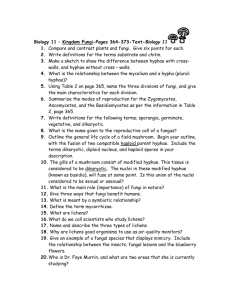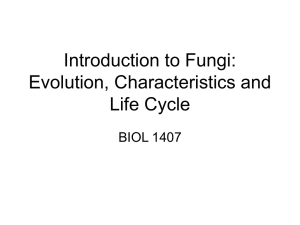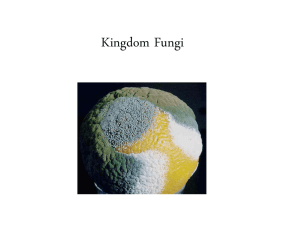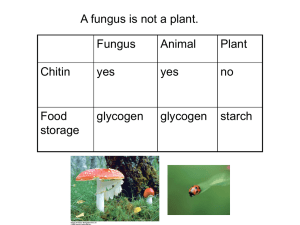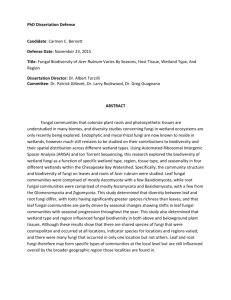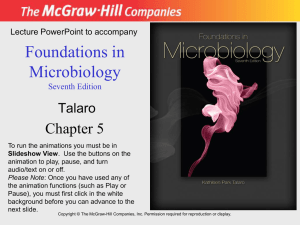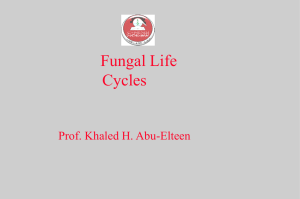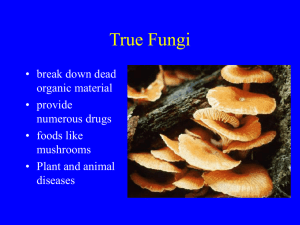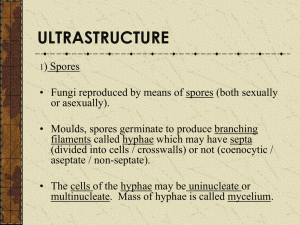I. The Characteristics of Fungi Hyphal septa
advertisement
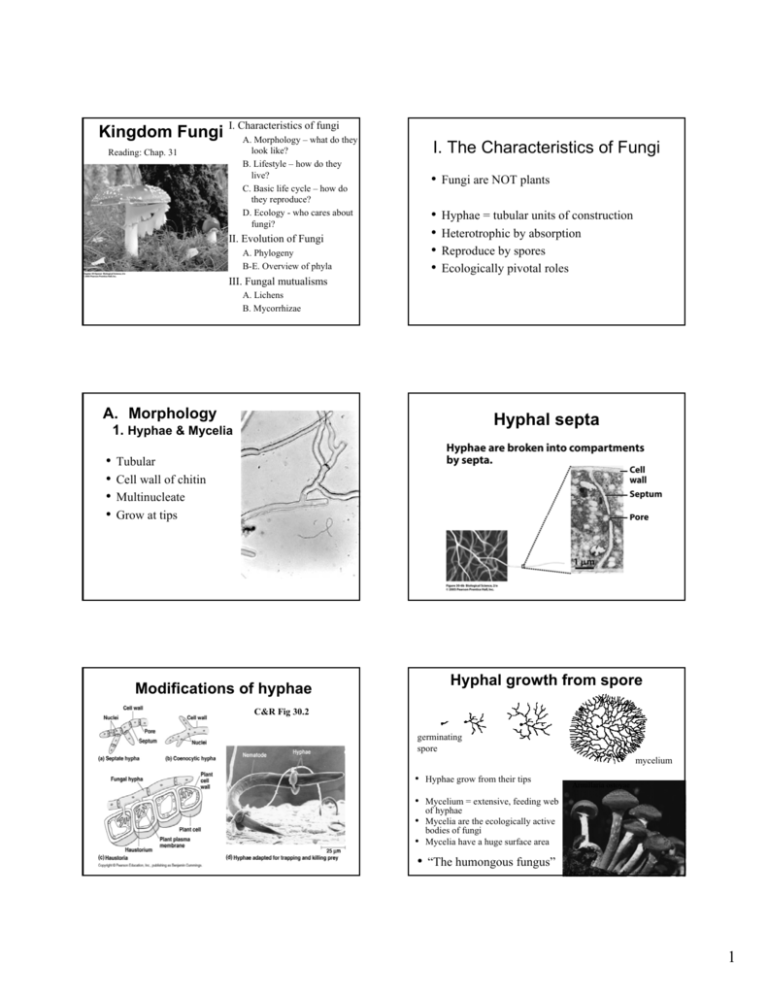
Kingdom Fungi I. Characteristics of fungi A. Morphology – what do they look like? B. Lifestyle – how do they live? C. Basic life cycle – how do they reproduce? D. Ecology - who cares about fungi? Reading: Chap. 31 I. The Characteristics of Fungi II. Evolution of Fungi A. Phylogeny B-E. Overview of phyla • Fungi are NOT plants • • • • Hyphae = tubular units of construction Heterotrophic by absorption Reproduce by spores Ecologically pivotal roles III. Fungal mutualisms A. Lichens B. Mycorrhizae A. Morphology Hyphal septa 1. Hyphae & Mycelia • • • • Tubular Cell wall of chitin Multinucleate Grow at tips Hyphal growth from spore Modifications of hyphae C&R Fig 30.2 germinating spore mycelium • Hyphae grow from their tips • • Mycelium = extensive, feeding web of hyphae Mycelia are the ecologically active bodies of fungi Mycelia have a huge surface area • “The humongous fungus” • Armillaria ostoyae http://en.wikipedia.org/wiki/Image:Armillaria_ostoyae.jpg 1 “Fruiting bodies” are also composed of hyphae 2. Yeasts • • Single celled fungi Adapted to liquids * Plant saps * Water films * Moist animal tissues C&R, Fig. 31.1 Candida albicans Saccharomyces cerevisiae B. Fungal Lifestyle: Heterotrophic by Absorption • • • • Fungi get carbon from organic sources Hyphal tips release enzymes Enzymatic breakdown of substrate Products diffuse back into hyphae • Saprobes * Decomposers * Mostly of plants, some animals • Parasites * Harm host * Mostly on plants, some animals • Nucleus hangs back and “directs” Mutualists Parasite/pathogen Mutualist C. Basic fungal life cycle C. Basic fungal life cycle Spores are reproductive cells * Sexual * Asexual • Decomposer * Lichens * Mycorrhizas * Endophytes (see book) Products diffuse back into hypha and are used • The Absorptive Lifestyle 1. Zygotic - haploid phase is dominant Formed: * Directly on hyphae * Inside sporangia * Fruiting bodies C&R, fig. 13.5b Penicillium conidia Pilobolus sporangia Amanita fruiting body 2 D. Who cares about fungi? 1. Decomposers Plasmogamy - fusion of cytoplasm Karyogamy - fusion of nuclei (gametes) Heterokaryotic = dikaryotic Also eat: - wood in houses, boats, fences; - food; - other materials - cloth, paint, leather, waxes, jet fuel, petroleum, paper, wire insulation, photographic film, to name a few. D.2. Agricultural pests What do all of these materials have in common? Stem rust They are all C-based. ergot Parasites Food spoilage D.4. Medicinals D.3. Food - morels, truffles, shitakes, common button mushrooms Pink ear rot • HUGELY IMPORTANT: Source of many antibiotics (active against bacteria) Penicillium, etc. • • • and hallucinogens: - Psilocybin - ergot (LSD) Truffles Morel 3 D.5. Yeast for brewing and baking: Saccharomyces cerevisiae II. Fungal Evolution A. Overview 1. Common eukaryotic ancestor with animals Fig. 28.7 2. Four phyla of fungi? Loss of motile spores B. Chytridiomycota – “chytrids” • • • Chytrids are a primary factor resulting in amphibian declines. Simple fungi Produce motile spores and gametes Mostly saprobes and parasites in aquatic habitats Fig 31.5 Chytridium growing on spores 4 C. Zygomycota C. Zygomycota Pilobolus, with asexual sporangia C&R, 31.8 1. Examples: - Rhizopus (C&R, fig. 31.6) Pilobolus Dance Group No longer considered one phylum - polyphyletic Formerly, many endomycorrhizae, too (e.g., Glomus) Now in their own group (Glomeromycota) http://www.youtube.com/watch?v=TrKJAojmB1Y http://www.youtube.com/watch?v=9CRNmde0WUc&NR=1 D. Basidiomycota - “club fungi” C. Zygomycota Mushrooms (e.g., Hygrophorus) 2. Life cycle Earthstars, puffballs a. No dikaryotic growth b. Both sexual and asexual sporangia 1. structure Shelf or bracket fungus a. Fruiting body: basidiocarp C&R, 31.11 2. Life cycle 1. structure b. Fertile layer on gills with basidia (“clubs”) c. Four spores per basidium a. Dikaryotic growth b. Fruiting body: basidiocarp c. Fertile layer on gills with basidia (“clubs”) d. Four spores per basidium e. Asexual reproduction is rare Russula d. Many Basidiomycetes are ectomycorrhizal. mushroom mycorrhizas on Western Hemlock root 5 E. Ascomycota “sac fungi” or “cup fungi” E. Ascomycota - Life cycle Scarlet cup Morels 1. Dikaryotic growth 2. Fruiting body: ascocarp 3. Fertile layer with asci 4. Eight ascospores per ascus (sac) 5. Asexual reproduction via conidia Truffles Many “lichen fungi” too! F. Deuteromycetes - “fungi imperfecti” • • • 1. Not a true phylum (not a natural group): polyphyletic 2. Fungi with no known sexual reproduction (“molds”) 3. Asexual reproduction by conidia III. Fungal mutualisms • • • • • • III. Fungal mutualisms Definitions: Symbiosis - 2 organisms living together in intimate physical contact Mutualism - both organisms benefit from the relationship Parasitism - one benefits, one loses Commensalism - one benefits, other not affected Questions: 1. Definitions of mutualism vs. symbiosis, mutualism vs. parasitism vs. commensalism 2. What fungal and photosynthetic partners are involved? 3. What is the “currency” of the mutualism? How do the partners benefit? 4. What is the structure and/or morphology of the organismal interaction? 5. What is the ecological importance? A. Lichens 1. Partners a. Fungal partner - gives protection - mostly Ascomycetes (~25,000 spp.) - only found in lichens (not free-living) - provide protection, receive photosynthate (fixed C) b. Photosynthetic partner - gives fixed carbon (sugars) - green alga or cyanobacterium - can be free-living - provide photosynthate (fixed C), receive protection 6 A. Lichens 2. Anatomy a. most of lichen body is fungal hyphae b. photosynthetic partner in a distinct layer c. sexual reproduction of fungal partner only d. asexual reproduction: soredia, fragmentation A. Lichens 3. Morphology fruticose crustose foliose medulla A. Lichens A. Lichens 4. Importance 4. Importance b. winter food for caribou and reindeer in Arctic a. rock weathering, soil formation in primary succession • acid secretion • trapping particulates • nitrogen fixation (cyanobacteria) A. Lichens 4. Importance c. Indicators: susceptible to pollutants B. Mycorrhizae • “mycor” = fungus, “rhizae” = root 1. Partners a. Fungus - gets fixed carbon (sugars) - Primarily Basidiomycetes and Glomeromycetes (which were formerly part of Zygomycetes) b. Plant - gets nutrients (mostly N and P) and water - about 80% of all plant species are mycorrhizal!! Raven et al. 1999 7 2. Structure: two types of fungal/plant contact b. internal (endomycorrhizae) (a.k.a. arbuscular mycorrhizae) - hyphae penetrate root cells - Glomeromycetes (formerly Zygomycetes) - 80% of all plants (many herbaceous) - relatively few fungal species: not plant species specific a. external (ectomycorrhizae) - fungal sheath around root - Basidiomycetes and about 5000 plant species (mostly woody) - many Basidio’s: fairly plant species specific Smith 1999 Fig. 31.18 Raven et al. 1999 Smith 1999 B. Mycorrhizae The End 3. Benefits - is it worth it? No mycorrhizae No mycorrhizae With mycorrhizae With mycorrhizae Fig. 31.19 8
